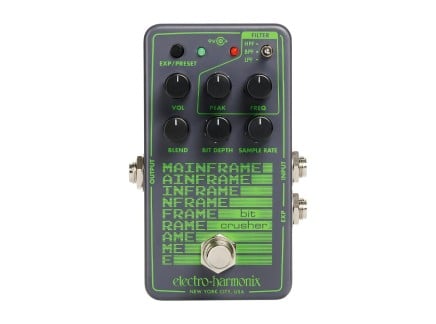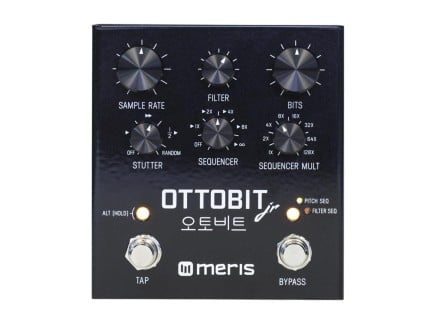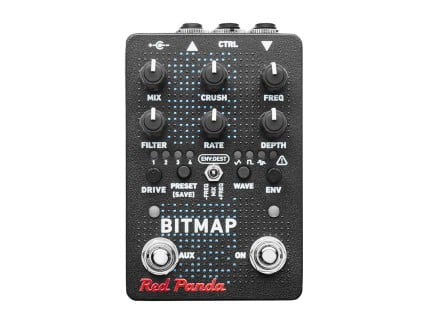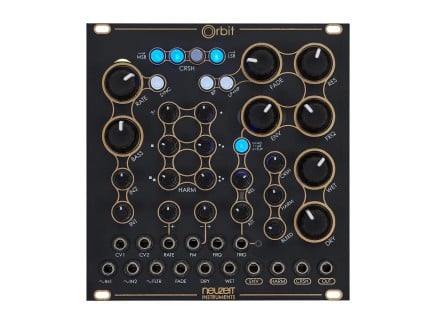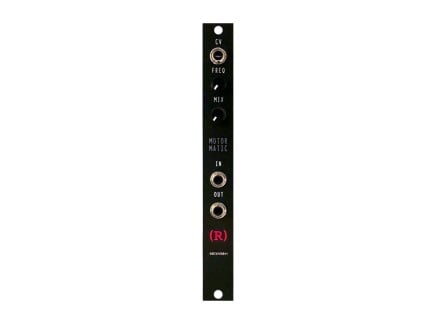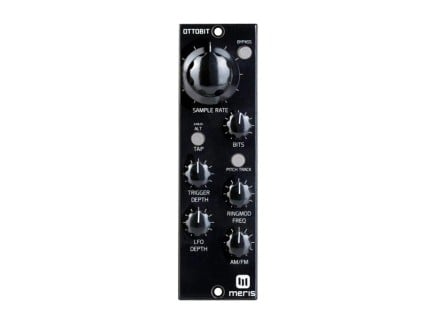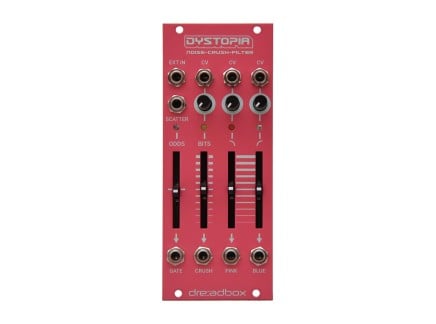Rooted in the rebellious spirit of pioneering recording artists and engineers and further embraced by musical counterculture movements, audio distortion effects have become a staple in the modern sound palette. From exploiting the fuzzy tones of torn-up amplifiers, broken tubes, and other malfunctioning audio equipment to the meticulously designed speaker-ripping guitar pedals of the modern day, it's safe to suggest that the aesthetics of distortion defined a large portion of the 20th century's tonal palette.
Different kinds of distortion effects manage to alter the audio signal passing through them in such drastic ways that the output signal not only gains a new set of harmonics, but is also transformed on a perceptual level through a sensed increase in power, altered disposition, and a highly reactive attitude. The non-linear quality of distortion effects also adds a layer of mystique—transforming subtle differences in performance dynamics into infinite differences (subtle and extreme) between the incoming and outgoing sound.
The variety of distortion effects we have harnessed over the years is vast, and each one carries its own very distinct behavior and tonal character. Interestingly, it appears that with every new step of technological evolution, with new ideas amplified by scientific and creative discoveries, we consistently stumble upon new ways to distort audio. One personal favorite distortion effect manifested itself in the very foundation of how digital audio works. Of course, I am talking about bitcrushing and sample rate reduction—the topic of this Weird FX article, and a true outsider in the realm of audio distortions.
The Principles of Digital Audio...and How to Break Them
Because the principles of digital audio are at the very core of bitcrushing and sample rate reduction effects (I will occasionally use "bitcrusher" and "SRR" as this article continues), it is impossible to go on discussing them without pivoting into a brief overview of how and why digital audio works the way that it does, so let's get right to it.
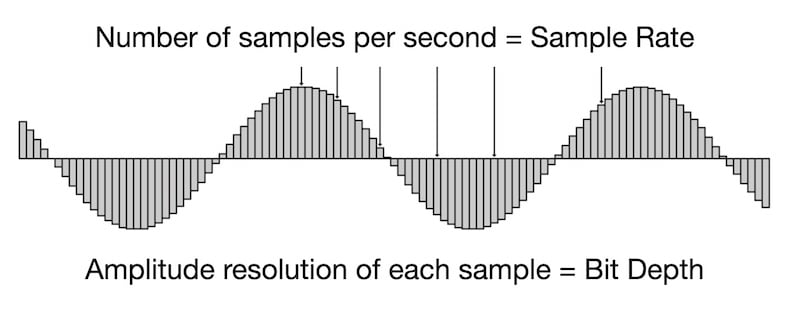
Analog signals are continuous fluctuations in voltage characterized by infinite possible amplitude values for every position in time. Since computers are not capable of storing or processing infinite streams of continuous information, a method and a set of tools have been devised for converting analog signals into discrete digital information—finite streams of 0 and 1 combinations that are then decoded into sounds. This process is known as analog-to-digital conversion (ADC for short), and its main stages are sampling, and quantization. Sampling corresponds to taking snapshots of the instantaneous amplitude levels of the input signal at regular time intervals. During the quantization process, the system allocates the sampled amplitude values to their digital representations based on the available resolution (determined by the number of bits). Both parameters significantly affect the quality of the output signal, and in both cases, the higher the number the better, but let's add a bit more clarity into that statement.
So, how can we know what should be the appropriate sampling rate for translating any given analog signal into the limited realm of digital? After all, higher sampling frequencies and resolution take a toll on processing power and memory, so in most cases, it's necessary to reach a compromise between quality and practicality. The solution to this question was offered by the Swedish-American engineer Harry Nyquist, who determined that in order to represent an analog signal digitally without any loss, the sampling rate should be equal to at least double the highest frequency in the source signal. For example, the standard sample rate for CD-quality audio is 44,100Hz (or 44.1kHz). Why exactly this number, you may ask? Well, most of the sounds we use for music pertain to the limit of our sense of hearing, whose upper end is around 20kHz. Additionally, some non-linear processing methods like distortions can generate harmonics beyond the upper limit, so a little extra room is just a necessary safety net. Therefore, 44.1kHz is sufficient for the majority of digital audio situations. Of course, there are cases where higher sampling rates are necessary, such as distortion and dynamic effects modeling, or recording ultrasounds emitted by bats and dolphins—thus it is common for digital systems to offer a selection of sampling rate options to choose from.
If, at this point, you are wondering what happens if the maximum frequency of the sampled signal is higher than the sampling rate? Well, meet aliasing—an audio artifact that occurs when certain frequencies in the source signal are undersampled, and effectively misrepresented at the output stage...often resulting in inharmonic sidebands unrelated to the original input audio. By most accounts, aliasing is a foe in the world of digital audio…but as you will hopefully see later in this article, it is also occasionally a friend (albeit with quite an attitude).
Now that we have made sense of sample rate, let's go ahead and decrypt the bit depth parameter. A bit is a measure of memory; each additional bit of memory exponentially increases the potential quality of the digitized sound. The expression for finding out the number of values a digital system can handle is 2^n, where "n" stands for the number of bits available. Thus, getting back to our CD-quality example, its 16 bits translate to 65536 possible amplitude values per sample, which in reality translates to changes in signal level that are smooth enough to be perceived by our ears as continuous. Fewer bits translate to fewer possible amplitude values, making it difficult for the system to reconstruct the amplitude fluctuations of the signal correctly, which consequently increases quantization error—the variance between the actual value of the sampled signal, and its quantized approximation. The product of quantization error is quantization noise, and the higher the error, the more audible is the noise. Fortunately, every added bit reduces the amount of quantization noise present.
Bit resolution directly corresponds to the dynamic range of a digital system or medium. By multiplying the available number of bits by the signal-to-noise-quantization-ratio (SQNR=6.02) we can find out the dynamic range of any digital system or medium. As an example, a 16-bit audio CD has a dynamic range of 96.3dB, while the resolution on modern lossless digital audio file formats allows for bit depth to be set as high as 32 bits resulting in a whopping 192.64dB dynamic range. By the way, if this was not clear yet, a higher dynamic range indicates that we can reproduce sounds digitally that are very very quiet and very very loud with a trace of quantization noise below the threshold of perceptibility.
Since the very early days of digital audio research, there have been ceaseless attempts to improve the technology, expand its potential and power, and to reduce noise. This led to the impeccable audio quality that we get to enjoy today. Yet, the audio effect that we focus on in this article, is a fully realized intention to do exactly the opposite. Thus most of the time, when we hear low-resolution sounds today, it is more likely to be a determined artistic decision than a technological shortcoming.
The Aesthetics of Bitcrushing
So how did we end up using bitcrushing and SRR as audio effects in the first place? Why, when we normally try to avoid aliasing and noise, do we sometimes intentionally degrade the quality of audio signals for aesthetic purposes? At least two influencing mechanisms come to mind here: one is somewhat functional, and the other is cultural. From a functional standpoint, as I've mentioned earlier in the article, any type of distortion effect increases the number of harmonics in an audio signal, making it brighter and perceivably more powerful. The particular pattern of the emerging harmonics, and the way it responds to changes in the dynamics of the source signal define the unique character of each distortion process. Bitcrushing and SRR effects undeniably exhibit a distinct range of tonal qualities, and are hard to be mistaken for anything else. As such, as a creative tool, it played an important role in shaping the sonic character of a number of electronic music genres including industrial, ambient, and techno.

The cultural aspect is a little more subtle, but let's try to unpack it. Often, when I write about particular effects or synthesis techniques, it is possible to trace their origin story back to a particular invention. With bitcrushing/SRR, the effect itself essentially emerged as a byproduct of technological limitations of a certain time period, much like the wow and flutter of magnetic tape or dust particles on a vinyl record. The resolution on early digital machines was much much lower than modern standards. For example, the sample engine on the iconic Roland TR-909 released in 1983 was only 6-bit, the infamous Casio SK-1 (pictured above) employed 8-bit samples with a mere 9.38 kHz sampling rate, and the resolution of Akai's MPC 60 (1988) was 12-bit. Essentially, the sound of bitcrushing and less than optimal sampling frequency became a defining characteristic of music machines released at the dawn of the digital age. As such, low-resolution sounds were intrinsic sonic elements in quite a lot of music produced between the mid-80s and late 90s.
Another aspect that presumably stimulated our present affection for low-resolution digital sounds is early arcade game and computer game music. Emerging in the early 1970s, computer games were among the first digital cultural artifacts of the new era. For an increased level of our engagement, it was only logical to add music and sounds to games. But, of course, because of practical limitations in processing power and memory, this wasn't an easy task—and it was practically impossible to create something that sounded even remotely like any real sound. Thus during this time, a new type of sound was introduced into the daily human soundscape. In early computers, a speaker was connected directly to the CPU boards, producing buzzing and clicking square waves in response to the instructions from a program written by a composer. Composers who created music for early computer games were restricted to a limited number of voices, and timbre options. They had to be inventive in order to create engaging tunes in a system so lacking in sonic variety and dynamics. This involved making use of fast-moving arpeggios, and psychoacoustic effects like pseudo-polyphony. And despite such drastic limitations, this yielded some of the most cross-culturally recognizable tunes of our time, including the Super Mario Bros' "Overworld Theme" and "The Legend Of Zelda" theme, composed by Nintendo's sound designer Koji Kondo in 1985 and 1986 respectively.
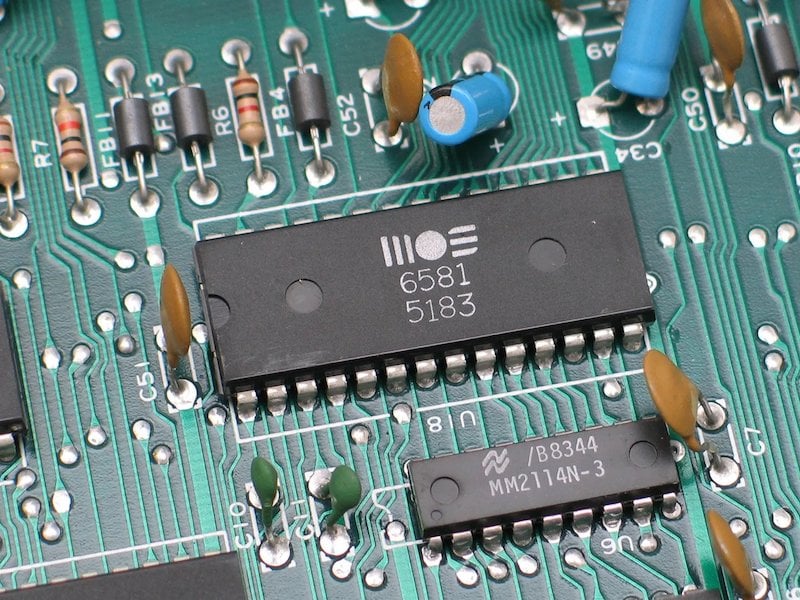
Importantly, since the late 1970s availability of personal computers, manufacturers started to develop and produce dedicated soundchips that, in some way similar to synthesizers, displayed their own distinctive sonic personalities, fueled by unique features and quirks. Over the years, some of those chips earned a loyal following. Among such was the well-loved SID chip originally designed for Commodore 64, and later reintegrated in new generation of electronic musical instruments like Elektron Sidstation (1999), and ALM Busy Circuits SID Guts Deluxe (2016) Eurorack module. (See above for a close-up of a MOS 6851 SID chip, via IEEE.org.) In 1987, Ultimate Soundtracker was released, marking the first historical account of tracker sequencers, and the beginning of homebrewed production of music on a PC. The music and the sound of that era became so dear to us that even once the audio resolution on our digital machines became arguably indistinguishable from analog sound quality, the spirit of that period is wistfully maintained within the 8-bit/chiptune music community.
To me, it is quite fascinating that sound and memory have such an interwoven relationship. Our favorite music's melodies and harmonies are not the only time-travel machines for our minds: the texture of the audio itself (propagated by the technology that produced) it is a major factor as well. Artists like Boards of Canada, Odd Nosdam, and many others seem to have grasped this link, employing a variety of early analog and digital equipment for evoking feelings of nostalgia, and sentimentality. This suggests that the sonic character of the dominating technology of a time period eventually becomes symbolic of that era. Furthermore, I find it particularly interesting that once we advanced our digital audio technology to extremely high resolutions, many of us collectively felt a certain lack of "aura" in the clean, noise-free sound. Thus, once the mischievously noisy and aliased sound of the bitcrusher/SR effect became aestheticized, it became common to see the effect as an option in modern production software and hardware machines. Occasionally, a fixed, mild version of that sonic character is also offered as a "vintage" or "lo-fi" mode in modern sampers.
Bitcrushing + Sample Rate Reduction: Levels of Complexity
At a basic level, bitcrushing/SRR hinges on just two parameters—sample rate and bit depth. However, over the years, a number of creative additions and fruitful combinations with other effects have been introduced, so these days bitcrushing/SRR effects may often appear much denser in features, and much varied in their sonic flavors.
A great example of a very unique and characterful bitcrusher/SRR effect is the nearly legendary OTO Machines Biscuit, released as a hardware unit in the late 2000s (now discontinued), and presently available as a plugin from Softtube and Universal Audio. The magic of Biscuit lies in a clever combination of bitcrushing/SRR with great-sounding analog filters and a variety of other processes like waveshaping, delay, filter sequencing, envelope filter, vibrato, and pitch-shifting. Its bitcrushing and SRR defined the general character and the intensity of the effect, ranging from extremely subtle to unrepentantly harsh. The dedicated "Dressed" and "Naked" parameters allowed for finding the right balance between the dry and processed signals. Available strictly independently, each of the other processes then transformed the device into a completely unique, and flavorful effect. Such sonic diversity makes Biscuit quite a suitable companion for any sound source, be it vocals, drums, bass, guitar, or a whole mix in a DJ set.
Noticeably, the bitcrushing/SRR plugins native to modern DAWs like Bitwig and Ableton have also become more nuanced over time. The recently-upgraded Redux in Ableton Live features a dedicated pre/post-filtering, waveshaping, and an added controllable jitter to the sampling clock—emulating the instability of a low-quality ADC. Bitwig's Bit-8 sports even more controls, with an added "Chance" parameter for occasional skipping, different quantization modes, and a noise gate.
Some of Our Favorite Bitcrushing/SRR Guitar Pedals
In the last decade or so, the landscape of guitar pedals has been continuously enriched with some incredible stompboxes exploring digital lo-fi tones. Like with the aforementioned OTO Biscuit, the unique sound of those pedals often is the result of combining bitcrushing/SRR with other types of audio effects, and modulation options.
For example, Death By Audio's Robot combines an 8-bit crushed tone with octave up/down pitch-shifting, and an arpeggiator mode which together manifests in nearly fuzz-like behavior. The Electro-Harmonix Mainframe allows you to get very close to classic arcade sounds with pitch-tracking mapped to sample rate parameter.
There are also a few excellent and much more feature-rich stereo options in the pedal format, including two of our favorite bitcrushing/SRR effects of all time: the Meris Ottobit Jr. and Red Panda Bitmap 2. Ottobit Jr. includes an internal sequencer assignable to pitch, sample rate, or filter frequency cutoff parameters, a transient-driven stutter engine, and a warm transistor ladder filter emulation for smoothing out the harsh high-end that comes along with the bitcrushing territory. Bitmap 2, on the other hand, is distinct with its variable input drive, multiple distortion/waveshaping modes, a 4-pole filter, as well as an assignable LFO and Envelope Follower as general-purpose modulation sources. Each of these also offers a wide range of options for MIDI or expression pedal control, making them some of the most playable bitcrushers ever created.
Bitcrushing/SRR in Eurorack Modular Synthesizers
As you may suspect, there are also plenty of options for creative audio decimation and degradation in the domain of modular synthesis. Some options, like the Mosaic Decimator simply offer the rudimentary features that one would expect from such effects. These are excellent ways to add a new sonic flavor to your arsenal—but some modules go a bit further into the peculiar possibilities of this effect.
The beautifully-named T-Wrex from Alright Devices operates within the expected sonic realm of bitcrushing/SRR, yet it offers an expanded set of options for control and interaction, such as decoupling of bitcrushing and SRR sections, external sampling clock input, a dedicated Sync input for the internal clocking oscillator, and CV inputs for every parameter on the panel.
There is yet another group of modules that exploit the concept of combining bitcrushing/SRR with several other functions and effects. Among such is the Dystopia from Dreadbox, which is a cross between a noise source, random burst, HP/LP filters, and bitcrushing/SRR. This amalgamation of functions makes Dystopia equally suitable to be used as a sound source, audio processor, CV processor, or even a flexible CV/Gate generator. Perhaps the most multifaceted example in this category, though, is the Orbit from Neuzeit Instruments, whose complexity is evident even from a quick glance at its panel. Orbit combines bitcrushing/SRR, harmonization, multimode filters, and an envelope generator/follower together. Similar to the previously-mentioned OTO Biscuit, Orbit allows us to intentionally introduce bit translation errors via inversion and muting of certain bits, which manifests as drastic changes of the distortion's harmonic content. The harmonizer section then aids in shaping the sound by layering up to five square wave oscillators on top of the input signal, following its fundamental frequency with options for further retuning and octave-shifting. In an alternative mode, square waves can be replaced with noise sources, presenting yet another layer for sonic alterations and tone shaping.
Some of the modules mentioned, like the aforementioned Alright Devices T-Wrex, are described as analog bitcrushers/SRR. How can that be? Well, the process of discretization of audio signals can be easily mimicked in modular synthesizers using some very basic modules.
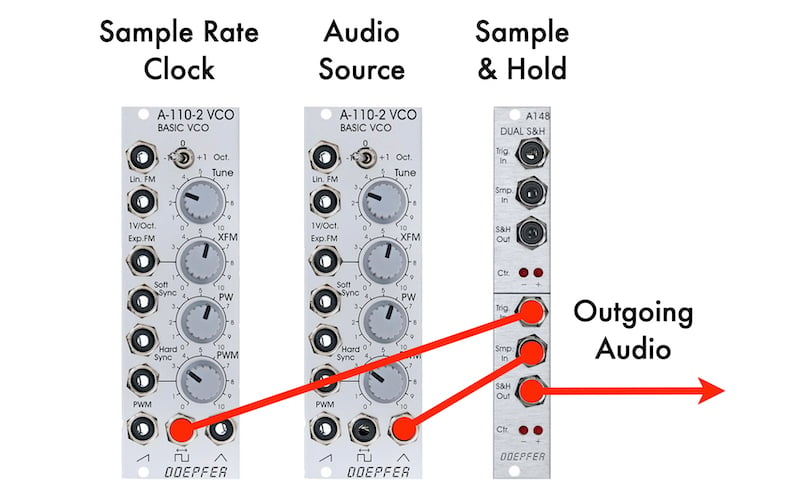
A sample-and-hold module paired with an analog oscillator is, essentially, all one needs to patch up an analog sample rate reduction effect. To do this, send a signal of your choice into the input of the sample-and-hold module, then send an oscillator output to the trigger input of the module, and voila! Your basic sample rate reducer is ready. As one would expect, the higher the frequency of the triggering oscillator, the closer the output signal will be to the original. Lowering oscillator rate effectively reduces the quality of the signal. This is an awesome trick, and one that can work wonders in even the most basic systems.
The effect of bitcrushing is a bit trickier in the analog synthesis realm, but I have experienced sonically similar results using a comparator module. A comparator turns any signal that passes through it into a square-ish wave based on the certain amplitude threshold. You can also add a couple VCAs into the mix to create a smooth crossfading between the original signal, and its "square-fied" output of the comparator.
Of course, once the basics are in place, nothing is stopping you from expanding your modular analog bitcrusher/SRR effect, and you can experiment further by adding filters, waveshapers, and other audio processors, as well as different CV sources for modulation.
A Crushing Outcome
This concludes our discussion of the wonderfully weird world of bitcrushing/SRR effects. We hope that you have something new to take out from this article, and that your sonic palette will get a little wider and a little weirder. Although seemingly simple on the surface, bitcrushing and sample rate reduction effects can really be a great asset in a wide range of musical endeavors. Whether you are adding a lo-fi tint to your mix, emulating sounds from vintage computer games, or totally submerging your beats into a noisy mayhem—bitcrushing/SRR is the way to go.





